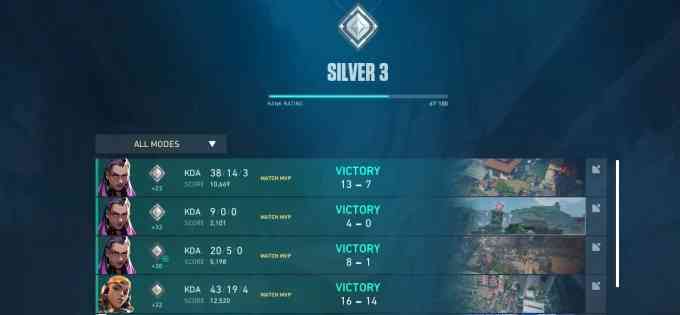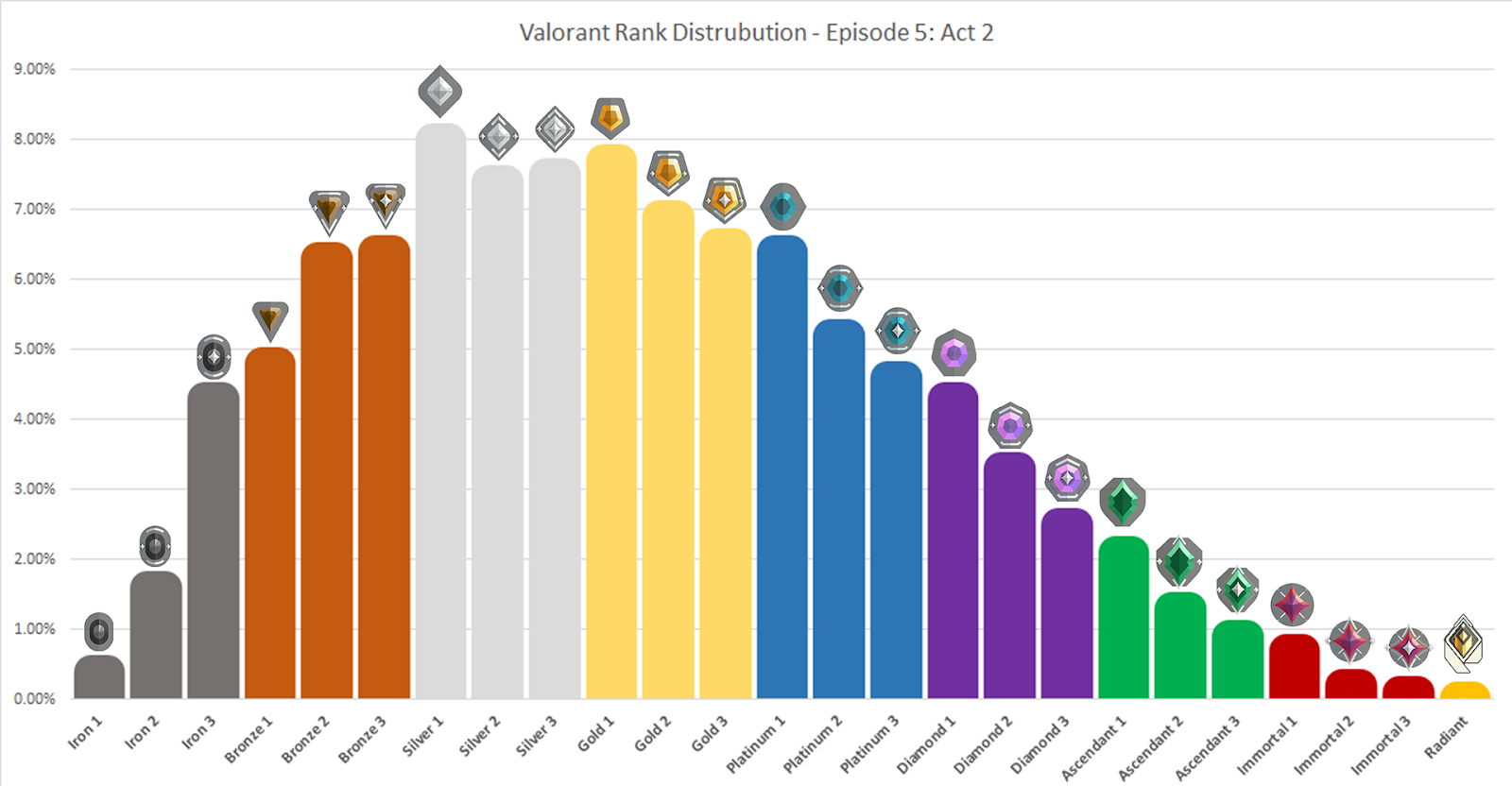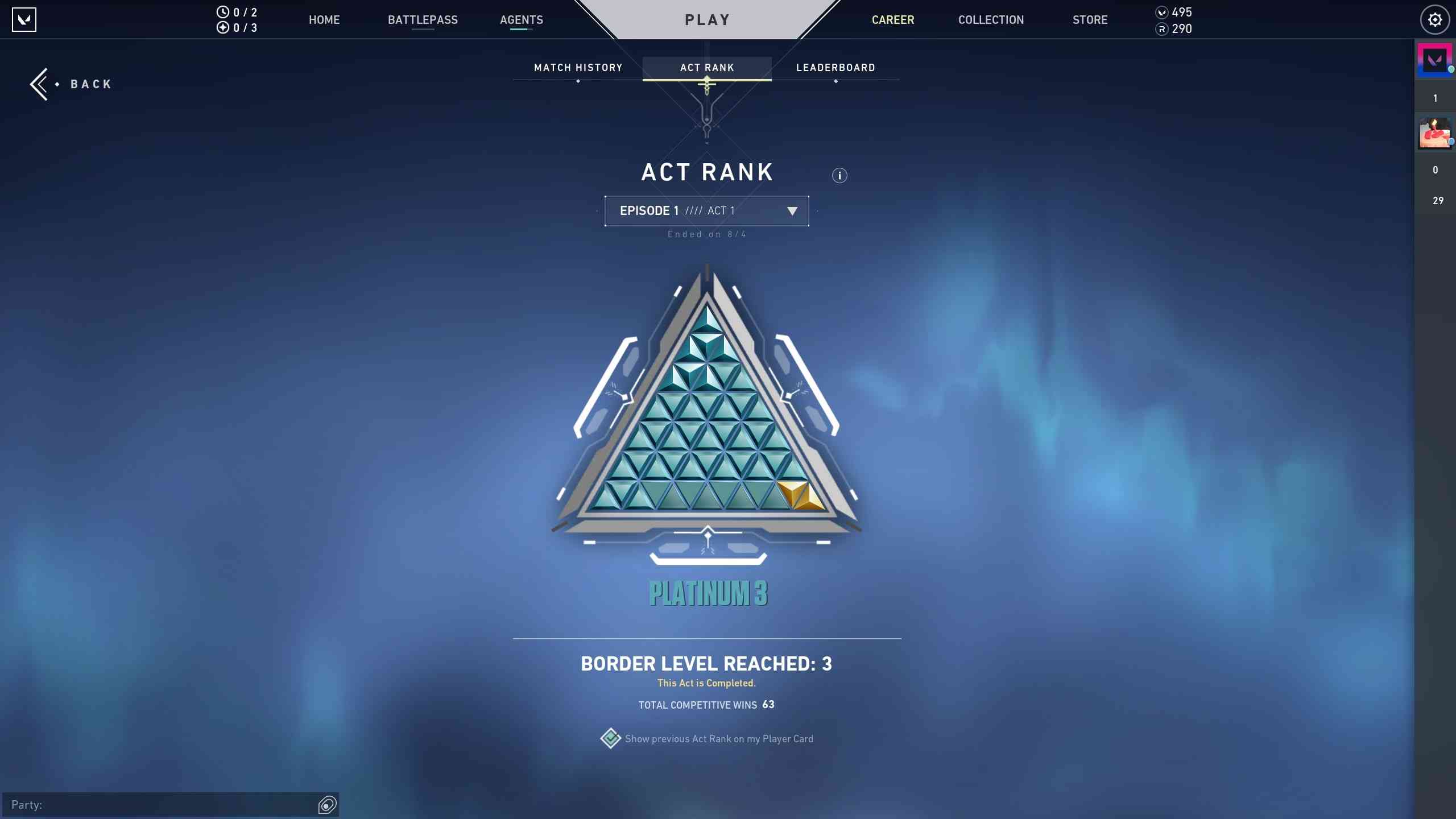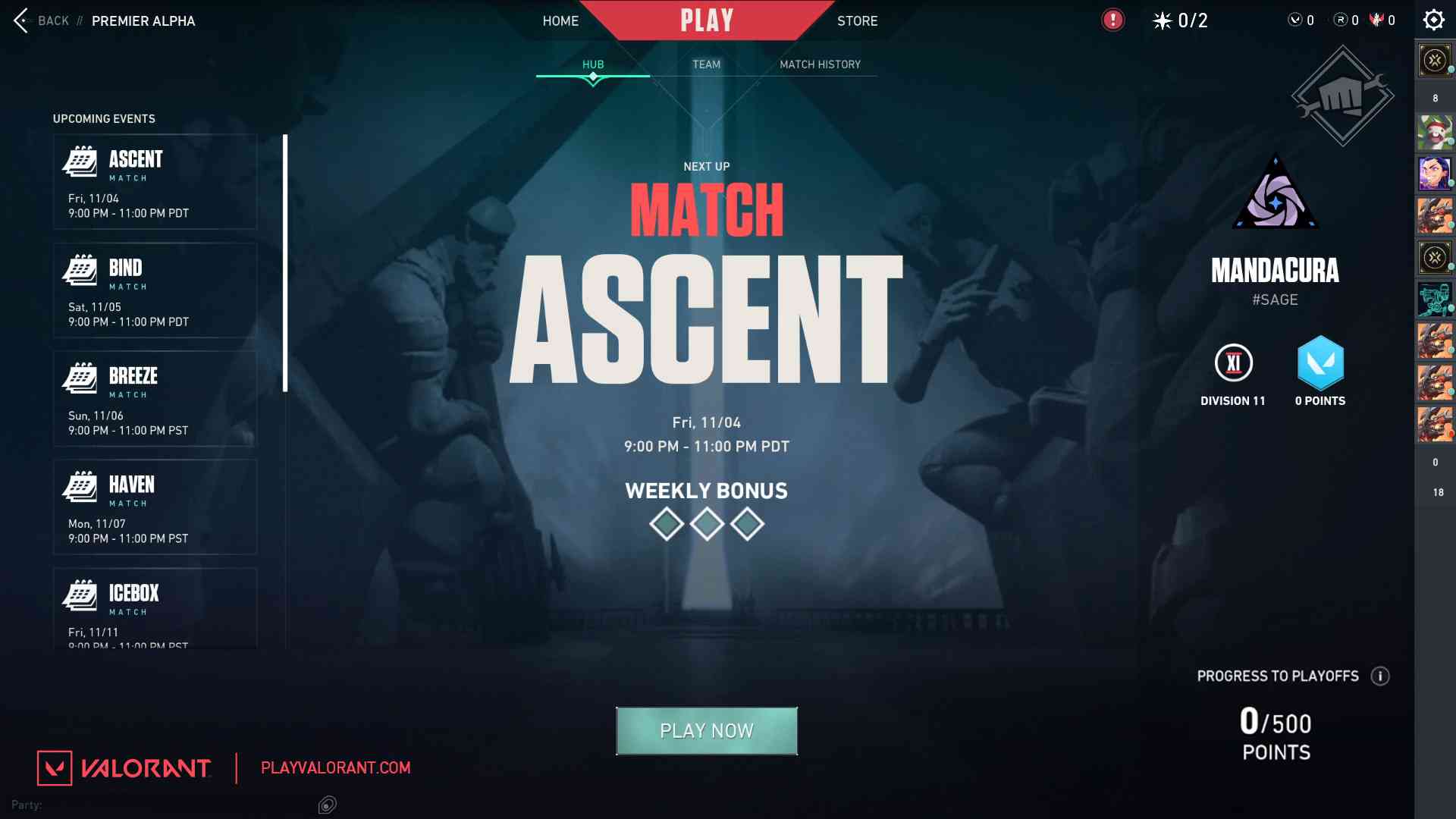A detailed and hierarchical ranking system structures Valorant’s competitive scene. It has been designed with great attention to detail to appeal to players at all skill levels. This system is not just a measure of progress but a testament to Riot Games’ commitment to creating a competitive environment. It rewards skill, strategy, and teamwork. Understanding the nuances of this ranking system is essential for anyone aiming to navigate the competitive ladder effectively.
Contents
- 1 Highlights
- 2 An Overview of Valorant’s Ranking System
- 3 The Hierarchy of Ranks and Tiers
- 4 Demystifying Rank Rating (RR), Act Rank Rating (ARR) and Matchmaking Rating (MMR)
- 5 Ranking Mechanics Inner Workings
- 6 Acts and Episodes Structure
- 7 Unlocking Ranked Play
- 8 Monitoring Valorant Rank Progress
- 9 Earning Valorant Ranks
- 10 Teaming Up for Competitive Mode Matches
- 11 Placement Matches
- 12 Seasonal Resets and Rank Decay
- 13 Summary
Highlights
- Comprehensive Guide to a Valorant’s Ranking System
- The entire list of available Ranks and Tiers
- Explanation of the Acts and Episodes Structure
- Description of the less evident ranking mechanisms
- Matchmaking Mechanics rules definitions
An Overview of Valorant’s Ranking System

One of the most crowded Ranks
Valorant’s structured tier system starts from the entry-level Iron tier and goes up to the elite Radiant Rank. Except for Radiant, each tier is divided into three sub-ranks. In a nutshell, the ranking system includes:
Rank Rating (RR):
- Visible to players;
- Increases with match wins and decreases with losses;
- Affects current Rank;
- Players accumulate RR to advance in Rank.
Act Rank Rating (ARR):
- Reflects the highest Rank a player has won during an Act and their performance across their best matches within the Act;
- It is shown on the player’s Act Rank Badge;
- Acts as a visual record of the peak skill level achieved in an Act.
Matchmaking Rating (MMR):
- Hidden from players;
- Creates balanced matches;
- Based on overall wins, losses, and individual match performance.
The Hierarchy of Ranks and Tiers

Valorant Ranks Distribution
All competitive ranks in Valorant are divided into nine tiers, ranging from Iron to Radiant. The following Ranks and sub-ranks structure Valorant’s competitive ladder:
- Iron: 3 sub-ranks, 100 RR threshold.
- Bronze: 3 sub-ranks, 100 RR threshold.
- Silver: 3 sub-ranks, 100 RR threshold.
- Gold: 3 sub-ranks, 100 RR threshold.
- Platinum: 3 sub-ranks, 100 RR threshold.
- Diamond: 3 sub-ranks, 100 RR threshold.
- Ascendant: 3 sub-ranks, 100 RR threshold.
- Immortal: 3 sub-ranks, with the RR threshold specific to the regional leaderboard.
- Radiant: The highest Valorant Rank includes no sub-ranks, with the RR threshold particular to the regional leaderboard.
Rank Group / Percentage
Iron – 6.3%
Bronze – 17.5%
Silver – 22.9%
Gold – 21.1%
Platinum – 16.2%
Diamond – 10.1%
Ascendant – 4.3%
Immortal – 1.0%
Radiant – 0.02%
Demystifying Rank Rating (RR), Act Rank Rating (ARR) and Matchmaking Rating (MMR)
RR (Rank Rating)
The numerical value that tracks a player’s progress up and down the competitive ladder.
Act Rank Rating (ARR)
A player’s badge shows the peak Rank achieved in an Act.
MMR (Matchmaking Rating)
A hidden numerical value representing a player’s skill level. Valorant’s matchmaking system uses it to pair players of similar skill levels against each other for fair distribution. Unlike RR, MMR is not directly visible to players.
Ranking Mechanics Inner Workings

Act Rank
Players ascend through the Valorant Ranks by accumulating RR. In general, reaching X RR in a given Rank will promote a player to the next Rank.
MMR Influence
If a player’s MMR is higher than what is typical for their Rank, they get more and lose less, encouraging them to reach a Rank more suitable for their MMR.
Regional RR Thresholds
Ascending through Immortal Two and beyond Valorant Ranks requires players to surpass specific RR thresholds that are determined regionally. For instance, to progress through the Ranks at the Immortal level, players must reach RR numbers that align with the competitive standards of their region.
Higher Rank Complexity
To achieve the Radiant or Immortal Ranks, players must exceed the regional RR threshold and be among the top 500 players in their region. For example, a player could have an RR higher than the regional threshold but still be ranked as Immortal three if they are outside the top 500.
Acts and Episodes Structure
Acts and Episodes divide the game’s competitive cycle. Each Act spans roughly two months. This provides a fresh competitive slate for players to showcase their skills. It allows a recalibration of the ranking system.
Valorant rewards players at the end of each Act based on their Act Rank Rating (ARR); rewards are exclusive cosmetics, with higher tiers offering more prestigious items.
- Acts: two-month periods where players can climb the Ranks and achieve a high Act Rank.
- Episodes: six-month periods. They comprise three Acts, providing a larger competitive canvas for players.
Unlocking Ranked Play

Competitive Play Starts
Ranked mode matches in Valorant become available to players once their account reaches level 20. This ensures players have a firm grasp of gameplay mechanics and map layouts. Therefore, all in the competitive arena have a foundational understanding of the game mechanics and strategies.
Monitoring Valorant Rank Progress
Valorant’s rank-tracking system visually represents a player’s competitive accomplishments. It shows their highest Rank achieved and the total number of wins within an Act. Players can track it through the in-game Career tab.
Earning Valorant Ranks
Ascending the Ranks requires accumulating RR points, and achieving a specific RR within a Rank results in promotion. But, the stakes rise upon reaching the Immortal Rank. The system becomes more stringent: players must exceed regional RR thresholds to advance. Each new Act and Episode involves Rank recalibration (Soft Reset).
A “Soft Reset” at the start of a new Act mildly adjusts players’ ranks to realign with their current skill levels. That serves better distribution, maintains competitive balance, and reflects existing player skills.
Teaming Up for Competitive Mode Matches

Competitive Mode Results Screen
Valorant allows players to form premade groups for competitive matches. The game has adjusted rules to ensure balanced gameplay. This flexibility reflects Riot Games’ commitment to a competitive environment, individual skills, and collaborative team strategy.
Players can queue for competitive matches with friends. The system adjusts to accommodate team sizes using MMR mechanics to ensure balanced play and fairness. It houses teams of varying sizes and adjusts RR gains and losses to maintain match integrity. That introduces specific rules for all five-player teams.
Placement Matches
Entering the competitive realm of Valorant begins with placement matches, a critical step that determines your initial rank in the game. These matches are designed to assess your skill level and place you in a rank that reflects your abilities, ensuring fair and balanced gameplay as you progress.
How Placement Matches Work
Eligibility Requirements: Before you can dive into placement matches, you must reach Account Level 20. This requirement ensures that all players have a basic understanding of the game mechanics, agents, and maps.
Number of Matches: You are required to play five placement matches. These matches are your gateway to the ranked ladder and are essential in determining where you start your competitive journey.
Performance Evaluation: The game evaluates your performance based on several factors:
- Win/Loss Ratio: The outcome of each match significantly impacts your starting rank.
- Individual Performance: Statistics like kills, deaths, assists, spike plants, defuses, and overall contribution to the team are considered.
- Unrated MMR Influence: Your Matchmaking Rating (MMR) from unrated games plays a role in the placement process, providing the system with additional data to accurately assess your skill level.
Significance of Placement Matches
Initial Rank Determination: After completing your placement matches, you’ll be assigned a rank ranging from Iron to Ascendant. The highest initial rank you can achieve is typically Ascendant 1, even if you perform exceptionally well.
Setting the Competitive Tone: Your starting rank influences the difficulty of matches you’ll face moving forward. A higher initial rank means competing against more skilled opponents, which can accelerate your improvement but also presents greater challenges.
Fair Matchmaking: Accurate placement ensures you’re matched with players of similar skill levels, creating a balanced and enjoyable competitive environment.
Tips for Success in Placement Matches
Prepare Adequately: Spend time warming up in practice modes or unrated matches to sharpen your aim and reacquaint yourself with game mechanics.
Agent Selection: Choose agents you’re comfortable with and that suit your playstyle. Familiarity with your agent’s abilities can give you a significant advantage.
Communication is Key: Use voice or text chat to coordinate with your team. Sharing information about enemy positions, strategies, and plans can turn the tide of a match.
Stay Positive and Focused: Maintain a positive attitude, even if a match isn’t going your way. Negative emotions can hinder your performance and affect team morale.
Review and Learn: After each match, reflect on your performance. Identify areas for improvement and adjust your strategies accordingly.
After Placement Matches
Rank Assignment: Once your placement matches are complete, you’ll receive your initial rank and rank rating (RR) points within that tier.
Progression Path: From here, every competitive match will contribute to your RR. Winning games and performing well will help you climb the ranks, while losses may cause you to drop.
Ongoing MMR Adjustment: Your Matchmaking Rating continues to adjust based on your performance, ensuring you face opponents that match your skill level as you improve.
Placement Matches in New Acts
Act Resets: With each new Act, your rank undergoes a soft reset. You’ll need to play one placement match to recalibrate your rank for the new Act.
Rank Decay Prevention: Regular play prevents rank decay due to inactivity, ensuring your rank remains a current reflection of your skill.
Seasonal Resets and Rank Decay
In Valorant’s competitive ecosystem, understanding how seasonal resets and rank decay function is crucial for maintaining and improving your rank over time. These mechanisms ensure a dynamic and fair competitive environment, encouraging players to stay active and continuously hone their skills.
Seasonal Resets
Valorant’s competitive play is divided into Episodes and Acts:
- Episodes: Larger content drops that typically last about six months.
- Acts: Subdivisions within Episodes, each lasting around two months.
At the start of a new Act, Valorant implements a soft rank reset to recalibrate the competitive ladder.
How the Soft Rank Reset Works
- Placement Match Requirement: At the beginning of a new Act, you’ll need to play one placement match to recalibrate your rank.
- Rank Adjustment: Your new rank will be slightly lower than where you ended the previous Act. This intentional drop is designed to:
- Reassess Player Skill: Ensure that your rank accurately reflects your current skill level.
- Promote Competitive Integrity: Prevent rank inflation and maintain a balanced matchmaking environment.
- Impact on Matchmaking Rating (MMR): While your visible rank resets, your hidden MMR remains relatively stable. This means:
- Fair Matchmaking: You’ll be matched with players of similar skill levels based on your MMR.
- Faster Rank Recovery: Strong performances can help you regain or surpass your previous rank more quickly.
Rank Decay
Unlike some competitive games, Valorant does not currently implement rank decay due to inactivity. This means:
- Rank Preservation: Your rank remains the same even if you take a break from playing competitive matches.
- Encouragement to Return: Players can return to the game without the concern of having lost rank progress due to time away.
Considerations for Inactive Players
- Skill Deterioration: While your rank doesn’t decay, extended periods of inactivity might affect your in-game performance due to rustiness.
- MMR Stability: Your hidden MMR might be slightly adjusted if you haven’t played for a long time, to ensure fair matchmaking upon your return.
Maintaining and Regaining Your Rank
To keep your rank reflective of your skill level:
- Stay Active: Regularly engage in competitive matches to maintain your gameplay sharpness and awareness of the evolving meta.
- Monitor Performance: Keep track of your performance metrics to identify areas for improvement.
- Adapt to Updates: Stay informed about game updates, new agents, and map changes introduced in new Acts and Episodes.
Benefits of Seasonal Resets
- Fresh Start: Seasonal resets provide an opportunity to reassess and set new goals for the upcoming Act.
- Meta Evolution: Each new Act often introduces changes that can shift the game’s meta, encouraging players to adapt and evolve their strategies.
- Competitive Fairness: Resets help maintain balanced competition by recalibrating ranks across the player base.
Tips for the Start of a New Act
- Early Placement: Complete your placement match early to get back into competitive play and start climbing the ranks.
- Review Patch Notes: Read the latest patch notes to understand any changes that might affect gameplay.
- Set Goals: Define what you want to achieve in the new Act, whether it’s reaching a higher rank or mastering a new agent.
Summary
The ranking system in Valorant not only enhances the matchmaking process by pairing players of similar skill levels for fair and competitive matches but also serves as a motivational tool. It sets clear goals and milestones for players, encouraging them to improve their skills and deepen their understanding of the game.
This system plays a crucial role in fostering a competitive community, as it promotes teamwork and strategic gameplay, enriching the gaming culture. Additionally, it offers players a sense of personal achievement and recognition within the game through tangible proofs like Rank badges. Moreover, the system is instrumental in identifying and nurturing esports talent, helping skilled players potentially rise to professional levels.



